|
|
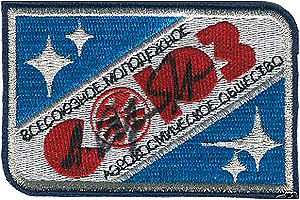
| Crew & Mission |
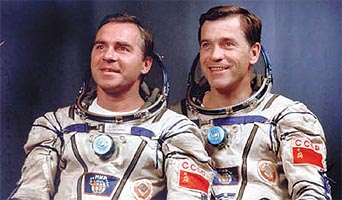
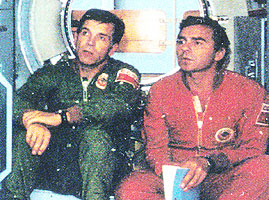
Left: Aleksandr Viktorenko (left) and Aleksandr Serebrov (right) in their training Sokols. Right: Serebrov and Viktorenko in their TK-2 training suits.
Soyuz TM-8 was launched on September 6, 1989 at 00:38 Moscow time. Commander of the mission was Aleksandr Viktorenko, with Aleksandr Serebrov as the flight engineer. Two days later, the spaceship docked with the aft port of Mir (Kvant-1) because the front port was occupied by Progress M-1 (arrived on August 25, 1989).
The crew (callsign "Vityaz") started preparing for one of the biggest events of their mission: arrival of the 20-ton Kvant-2 module. Launch was planned for October 16, but a problem with computer equipment forced a 40-day delay.
Kvant-2 was finally launched on November 26, 1989. The Progress M-1 was undocked on December 1 to make room for Kvant-2. Like the Kvant-1 approach, problems arrose when the module was in close proximity of the space station on December 2. Kvant was closing in too fast and terminated its approach at a distance of 20 meters. The Argon-16B control computer aboard Mir also experienced some problems and shut down.
A second attempt on December 6 was succesful. Following docking to the front port of Mir, the module used its Lyappa-manipulator to move itself to the top port of Mir's docking node. On December 12, Viktorenko and Serebrov undocked Soyuz TM-8, flew around the station and redocked to the front port. Progress M-2 then docked to the aft port on December 22.
Next was a series of five spacewalks. During the first walk (2 hours, 56 minutes) on January 8, 1990, the cosmonauts installed two 80-kilo star-sensors for the new Salyut-5B guidance computer on Kvant-1. The second spacewalk (2 hours, 54 minutes) took place three days later, on January 11. They removed the ERA-structure erected by Jean-Loup Chrétien, removed his Enchantillons exposure-experiment and made preparations for the arrival of the next module, Kristall.
The final three spacewalks were devoted to testing the Kvant-2 airlock and the new Orlan-DMA spacesuits without umbilical (January 26, 3 hours, 2 minutes) and flying the 218 kilo maneuvering unit 'Ikar' (Serebrov: February 1, 4 hours, 59 minutes, 33 meters from station; Viktorenko: February 5, 3 hours, 45 minutes, 45 meters from station). Both spacewalkers kept attached to the station by a safety wire. Viktorenko carried a radiation monitoring device (Spin 6000) to measure radiation around Mir.
Four days after the fifth spacewalk, Soyuz TM-9 with cosmonauts Anatoly Solovyov and Aleksandr Balandin arrived at the station. Viktorenko and Serebrov undocked their TM-8 ship from Mir on February 19, 1990 and landed at 07:36 Moscow time, 55 kilometers Northeast of Arkalyk in Kazachstan. Their mission had lasted 166 days, 6 hours, 58 minutes and 15 seconds.
| The Real Thing |
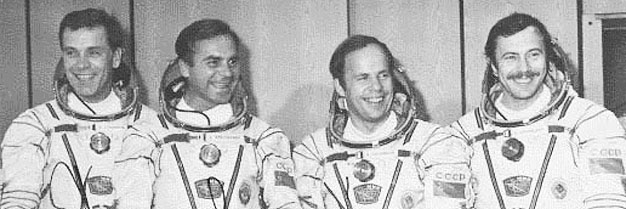
Aleksandr Serebrov (left) and Aleksandr Viktorenko (center, left) with back-up crewmembers Anatoly Solvyev (center, right) and Aleksandr Balandin (right) in their flight Sokols.
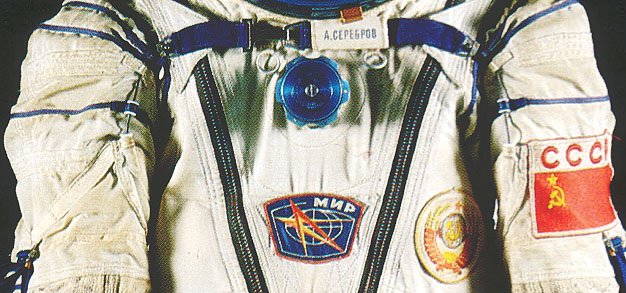
Serebrov's Sokol seen in the March 1996 Sotheby's Russian Space History Auction. It was identified in the catalogue as his Soyuz T-7 suit, which is impossible because of the patch layout. The only problem with this being Serebrov's TM-8 suit, is that the nametag seems to be smaller than the one shown in the pictures before launch. Since the nametag was removable, it has probably been replaced by an unflown version, with the flown version either in Serebrov's own collection of sold seperately.
Except for the souvenir-patch shown at the top of this page, the mission did not have any official patch. The cosmonauts were launched with a standard patch configuration on their Sokols: a second generation Mir-patch at the front of their suits, a CCCP flag (rounded letters, fully embroidered) on the left sleeve and a Soviet seal (yellow border) at the left lower chest.
With the majority of activities happening outside of Mir, we do not have any pictures which were taken onboard. We have no reason to believe that the configuration on the Penguin suits and PK-14 jumpsuits was any other than standard, with the Mir patch attached to the right pocket, the Soviet seal attached to the left pocket, a nametag on the left upper chest and a CCCP flag (silk type, rounded letters) on the left sleeve.
| The Orlan DMA EVA-suit |
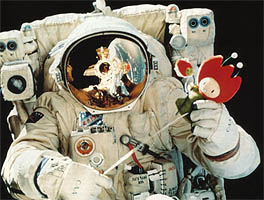
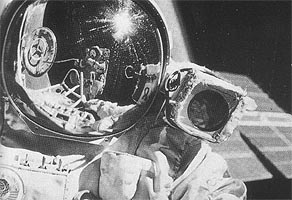
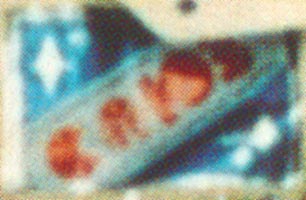
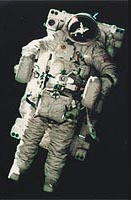

Upper left: Serebrov near the Kvant-2 airlock, wearing Orlan DMA-8 and the Ikar-mobility unit during his and Viktorenko's fourth spacewalk on February 1, 1990. On the front of his suit, he added a temporary patch or sticker reading "Soyuz". Upper right: Viktorenko's suit (DMA-12) did not have this patch. Note the reflection of Serebrov in his helmet visor. Lower left: a close-up of the Soyuz-logo. Lower center: Serebrov (DMA-8) riding the Ikar unit. Lower right: Viktorenko (DMA-12) doing the same.
Viktorenko and Serebrov staged five spacewalks. The first two were performed in DMA-6 (Viktorenko, red stripes) and DMA-10 (Serebrov, blue stripes). The other three walks were made in Orlan DMA-12 (Viktorenko, red stripes) and Orlan DMA-8 (Serebrov, blue stripes). Both suits had been delivered to Mir aboard Progress M-1 in August 1989. The patch configuration on both Orlans was the same as DMA-6 and DMA-10. On his 'Ikar'-outing, Serebrov had attached a "Soyuz"-logo above his electrical control panel. This was a reference to the All-Russian Youth Aerospace Society (Vserossiiskogo molodezhnogo Aero Kosmicheskogo Obshestva; VAKO) "Soyuz", of which Serebrov was the president. We believe he did not wear an embroidered patch, but a sticker, which was printed on silver foil. (See also: the VAKO-patch).
| Collecting TM-08 |
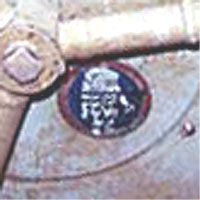
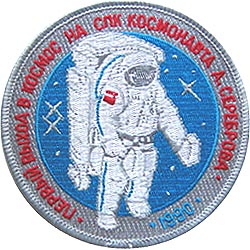
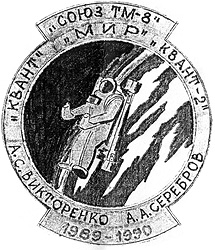
Left: Commemorative logo seen at the Mir airlock. Center: The same logo as a souvenir patch. Right: Design made by Vadim Molchanov after the mission.
The "VAKO-Soyuz" patch and sticker were available from Alex Panchenko in 2003. He received them directly from Aleksandr Serebrov. The souvenir 'Ikar' patch shown above, was produced by Stewart Aviation in England. The design of journalist Vadim Molchanov was one of many "retrospectiv" commemorative designs he sent to Stewart Aviation. Most of them, including this one, were never produced due to financial reasons.